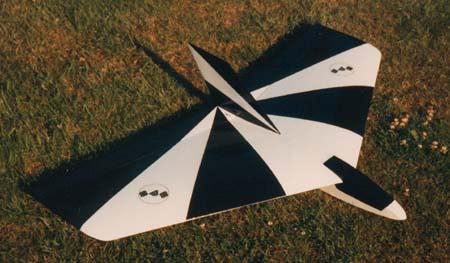|
SAS Thing - A Rookie's Review
Kit Review by Trevor Hewson (Originally written in 1987 for 'Sloping Off', the magazine of the Christchurch and District Model Flying Club)
Alan Head of SAS obviously prides himself on a personal and prompt service and within a week of posting off my cheque a large plain brown cardboard box duly arrived. Most of the space inside was taken up by a huge, oddly shaped foam wing pack. Once this is removed you are left with a few small bundles of balsa and ply stock, two pre-cut fuselage sides and the usual bag of bits. The kit is complete down to hinges, linkages, wing joining bandage and SAS stickers. You also get a plan, two pages of instructions and six pages of the Horsham & District Advertiser. Tasteful purple tissue paper my look prettier but, at £22.50 including postage and insurance, the local rag represents an understandable and effective economy - in keeping with the plain cardboard box. The Plan contains full size profile drawings and useful sectional and detail sketches. There is though no plan view and no overall sketch of the finished aeroplane. The instructions are brief and clear - and also unillustrated! Even the SAS catalogue contains pictures of all their models - except the Thing - so you are kept in suspense over the appearance of the finished model until it takes shape on the bench. Building The 1/16" ply fuselage sides are next glued to the underside of the wing and extend forward, joining on a tapered balsa noseblock. Ply top and bottom sheeting completes a fuselage whose sole purpose is to protect the servos on landing and hold the rest of the gear vaguely in the vicinity of the wing. Its shape though is quite pleasing and the nose length has been carefully designed to obtain a suitable c.g. position without additional noseweight. Apart from adding the fin and finishing to taste, that's it. Installing the gear prior to finishing left me with nearly two feet of aerial flailing about behind the model with a worrying tendency to get trapped between the elevons and the fin. After pondering this for a while, I decided to set a tube into the trailing edge, leading the aerial out through the wing tip. This accommodates practically the full length of the wire and, if the elevons are top hinged with tape as Alan Head recommends, doesn't get in the way of anything. With the fuselage finished in Solartex and the wings in Solarfilm, my Thing weighs in at just under 28oz which I reckon works out at a wing loading of about 9.5oz/sq ft (or 8oz/sq ft. if you count the 80 sq ins of elevons!). Control throws for the elevons are recommended at +/- 3/4" each for elevator and aileron movement, giving an alarming total throw of three inches! When I connected up the linkages the reflex came out at a recommended 3/16" and I had +/- 1/2" for each of the control throws. This happily coincided with Alan Head's recommended 'docile' settings - although he had stressed that, even set up like this, the Thing is definitely not a Rookie's model! Well, there's only one way to find out... Flying When the breeze eventually stirred it was clearly a South Westerly so the convoy duly followed our editor to a more appropriate slope. Within the next half hour conditions improved slightly from 'Heron-at-the-bottom-of-the-hill' (Keith), through 'Sinking-Alpinas (Iain), to 'Hang-in-there-with-a-High-Sierra' (various). At this point the editor returned with Alpina muttering that there wasn't even enough lift to land (I'm sure that's what he said!) and departed to the Purbecks (and so can put away his red pencil for the rest of this review). By late afternoon the wind strength reading was up to 'Marginal-for-a-Middle-Phase' and looking unlikely to get better. John Campkin was duly prised from his cup of coffee, given the transmitter and designated Test Pilot of the day. He gave a casual waggle of the stick, saw the extent of the elevon travel, picked his jaw up off the ground, used it to emit a muted 'Wow!' and decided to concentrate. I gave the Thing a good heave and, to my surprise and, I think, to John's relief, it flew away straight and level. A short flight, mostly downwards, confirmed that trim and c.g. were ok, rolls were in the blink-and-you'll-miss-it category even at low speed, and excess 'up' results in a gentle mushing sink. Control response, as predicted, was decidedly twitchy and discretion dictated that my first go on the controls would wait for a day with a bit more lift. The following Friday evening the wet south west wind, which had rained off Wimbledon all week, shifted southwards a little and the rain stopped. A phone call to Blobmaster Chaldecott to tear him away form his building met with a lukewarm response until I played my trump card: "I've got a Thing for you to test fly". "I'll be there!" came the hoped-for reaction and so, there we were on the local clifftop ready to enact 'Thing -2'. Peter's testing could best be described as thorough. To put it another way I eventually got a go! The Thing certainly is responsive but the responses are the right ones and it is surprisingly forgiving - it responded to my first half-hearted attempt at a loop by doing the well known 'Obelix flip' and levelling out with very little loss of height. Inverted performance was good in Peter's hands but my rather clumsy entry manoeuvre resulted in some loss of airspeed and demonstrated that the Thing will mush inverted just as well as it will the right way up. I entrusted the landing to Peter and, when he finally got round to it, he declared that it was the easiest model he had ever landed. All-in-all Alan Head's description of the model as 'a fast aerobatic 2-channel fun model' seems wholly accurate. Summary |
|
